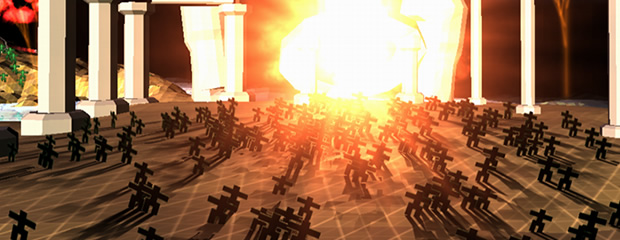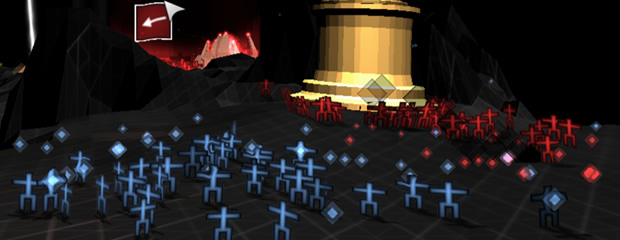

In order to become an experience worth remembering, games can excel in one of two ways. They can excel by taking a concept and improving upon it in such a way that it becomes a new milestone in gaming history, like Call of Duty: Modern Warfare and Starcraft did. The other option, is for developers to create a truly unique game that is worth remembering for the experience alone, which has brought us games like Braid and LittleBigPlanet. When Introversion Software released Darwinia for the PC in 2005, it was clear that this game would fall into the latter category. Now, almost five years later, Introversion has re-released the game and it’s multiplayer spin-off Multiwinia (2008) for the Xbox Live Arcade, under the name Darwinia+.
Everything in the Darwinia+ takes place in a virtual world known as Darwinia. This world exists entirely within a computer and is an experiment operated by a scientist. The Darwinians, which inhabit this world, have existed for countless generations and have built up their own civilization, complete with a rebirth cycle and religion. Over the course of time, the Darwinians evolved and have become increasingly autonomous, slowly experimenting with the technology used by their creator to shape their world. Unfortunately, Darwinia eventually comes under attack by a virus that all but annihilates the Darwinians. It is up to you, the player, to rescue the Darwinians from the virus and rebuild the Darwinian civilization.

The world of Darwinia is inhabited by small creatures known as Darwinians. Over the course of many generations, the Darwinians have built a complete civilization with its very own religion and rebirth cycle. While Darwinia+ is unique in many ways, the world of Darwinia is especially memorable due to its unique design and quirky inhabitants.
The game does not fit a particular genre, but comes closest to a crossover between a God game and a Real-Time Strategy (RTS) game. The player is initially able to create a single type of combat unit and use this to combat the Virus. To succeed, the player must harvest the ‘souls’ left behind by defeat Virii and turn them into friendly Darwinians. These Darwinians are autonomous and can therefore not be controlled directly. However, players are able to exert some control over them by appointing Officers and using these to provide simple orders such as a move order or a ‘follow’ command. Mission can often only be completed by building a large population of Darwinians and transporting them safely across the map in order for them to operate certain machinery.
In order to help the Darwinians rebuild their civilization, the player is able to build three specific units. The offensive unit can be ordered around or controlled directly. While these squads are able to defend against single enemies just fine when left to their own devices, the player must take control of a squad when launching an attack on a virus-infested area, as the offensive powers of the units increase dramatically when under the direct control of a player. Controlling units is a little clunky at times, as players are unable to adjust the camera angle while in this mode, but this is more than made up by the fact that the combat is far more engaging than in ‘conventional’ RTS games. The other two units include the Engineer, an unarmed utility vehicle that can capture buildings and harvest the souls needed to build Darwinians, and the Armor, a APC capable of transforming into a formidable Darwinian-operated turret. These units can be improved by researching upgrades for them, which generally increases attributes like firing range or firepower.

Though the turrets are incredibly powerful, the Darwinians that operate it are vulnerable to attack. Almost all buildings in Darwinia and Multiwinia require the power of Darwinians to function.
There is no resource-harvesting present in the game, but players are limited to operating only 3 (or 5, when the ‘Task Manager’ is upgraded to the highest level) units at any one time. Units can be deleted at will, and new units can be created at various controlled locations around the map. The population limit forces the player to focus on a single thing at a time, which slows down the pace of the game but increases the engagement you have with the Darwinians significantly.
This engagement is rarely felt in games, and it is what makes Darwinia an experience well-worth remembering. Throughout the game, you lead the Darwinians through several key locations within their world. All of these locations have a unique look and feature different machines that need to be operated by the Darwinians. The level design is simple, yet effective and the world truly begins to come alive as soon as the Darwinians begin to operate the machinery.
None of the missions are incredibly difficult, and unfortunately, the design of the final level readily lends itself to be exploited and can therefore be completed in less than 15 minutes without any major battles. Nevertheless, it is extremely satisfying to play through this game and rebuild the Darwinian society. An epilogue mission is also available, and while it is not directly connected to the story, it serves as a far more ‘worthy’ conclusion that the final mission of the story.
The game has a slightly religious undertone, as the basic story revolves around a evolving civilization that uses the tools left behind by its creator to shape and explore the world further, but then brings itself into danger as it is not yet ready to control such power. It is then rescued by an individual directly appointed by the creator himself, who guides the inhabitants of Darwinia and gives them a purpose in their existence. Frankly, this makes the game far more of a ‘God’ game than any other I have had the pleasure of experiencing.
As with the controls and gameplay of Darwinia, the visuals are simple yet effective. Each level has it’s own unique look and feel, but the 80s-retro-look remains consistent throughout the entire game. The audio is a little less consistent. Music is used sparsely but always manages to strike the right tones, and the happy chirping of the highly pixelated Darwinians fits their form incredibly well. Unfortunately, the sounds produced by lasers, cannons and explosions can most accurately be described as ‘unnecessarily loud’ in comparison to all the other sound effects in the game.

Multiwinia has players face off with armies of Multiwinians. This multiplayer mode is incredibly dynamic and is surprisingly entertaining.
Multiwinia is also part of Darwinia+ and serves as a multiplayer variant of Darwinia. Players control armies consisting primarily of Darwinians that must capture and hold several strategic locations. The game includes several variants of game modes found in regular RTS games, such as Deathmatch, King of the Hill and Capture the Flag. Matches are generally short, with time limits of 10 or 15 minutes being applied to most gametypes. However, the limited degree of control players have over the Darwinians themselves, combined with the very limited number of units that can be controlled at any one time, makes Multiwinia a fun game to play despite it’s obvious shortcomings as a Strategy game. The tide of a battle can change quickly, especially as many games feature 3 or more players fighting over the same objective. This creates a dynamic and fast paced multiplayer experience that is highly enjoyable. Ideally, Multiwinia is a game you wish to play with friends as it is one of those games where you do not appear to be playing against the other player, but rather just having a lot of fun together. Even when not winning, you will most likely finish matches with a smile on your face.
Darwinia+ is not one of those games that deliver tough, fast-paced action or provide great challenges that require skill and complicated strategies to complete, and therefore might not appeal to all gamers. However, the game does deliver a one-of-a-kind experience and a journey through all aspects of a civilization that is not entirely unlike our own. The price of 1200 MS points ($15) might be a little steep when compared to many other games available on the Xbox Live Arcade, but it is incredibly good value for the amount of quality you receive for it. If you are one of those users who would like to experience one of the most unique and enjoyable videogames in recent history (and did not play this game when it was released on the PC in 2005), I highly recommend you pay a visit to Darwinia.

Such a cool game!!!